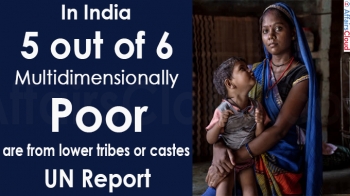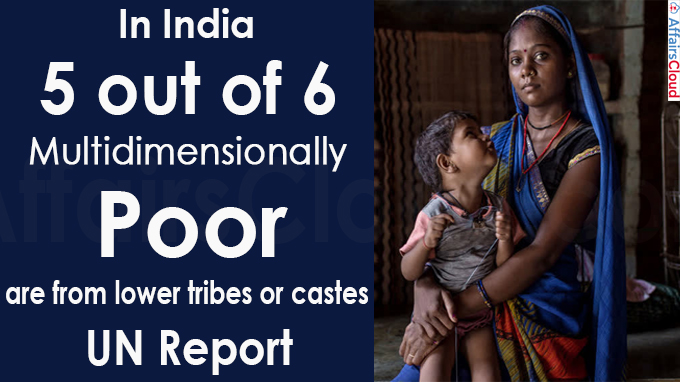
.png) Jaswant Kaur
Jaswant Kaur

Nearly two years ago, a report published by the United Nations Development programme (UNDP) and the Oxford Poverty and Human Development Initiative (OPHI) brought cheers to many Indians. The report stated that the country had lifted 271 million people out of poverty from 2006 to 2016. Naturally enough, we all went gaga over it.
At least it gave an impression that India will soon be able to bring more and more people out of poverty. No one at that time imagined that an unknown, invisible virus would cause high-level disruption and will expose the policy paralysis that haunts the current regime.
A week ago, the 2021 Multidimensional Poverty Index (MPI) report was released. It did not create the euphoria that it created in 2019. Rather, the report did not receive much attention for obvious reasons. Except for a few newspapers, not much coverage was given to it. The pandemic has adversely affected the performance of almost all countries.
Before we move further, let's look at what the acronym MPI means. The global MPI measures acute multidimensional poverty for more than 100 countries. It takes into account three major factors – health, education and standard of living. Each of these three factors is measured against 10 different indicators.
For instance, health is measured in terms of nutrition and child mortality rate and progress in education is calculated on the basis of the number of years of schooling and school attendance. The standard of living takes into account access to cooking fuel, sanitation, drinking water, electricity, housing and ownership of certain assets.
The index was launched in 2010 and is calculated annually with a fresh analysis. For the first time, the report shows the effect of ethnicity or race or caste and gender of the family head while calculating the index. In other words, the report shows the intersectionality of various factors that contribute to MPI.
People are considered as multidimensionally poor, “if they are deprived in one-third or more of 10 indicators, where each indicator is equally weighted within its dimension”. The MPI ranges from 0 to 1, and higher values imply higher multidimensional poverty.
The report has laid bare the age-old caste system and its effect on poverty in India. It also shows why we still need a reservation policy to uplift those coming from the socially and educationally backward families, especially scheduled tribes, castes and backward classes.
It says that five out of six multidimensional poor in India belong to scheduled tribes or castes or other backward classes. Of the 227 million people who live under multidimensional poverty in India, 9.4 per cent are from scheduled tribes, 33.3 per cent from scheduled castes and 27.2 per cent from other backward classes. What B R Ambedkar, the founding father of the Indian Constitution, wanted to achieve in 10 years is still “work in progress”!
While a majority of government schemes have been made to help those coming from the scheduled castes, tribes or other backward classes, these schemes have no backing in terms of the number of people belonging to these categories. Simply put, they are just announced randomly to garner votes or mollify the people. Not only this, some people belonging to a particular occupation are also labelled as “other backward classes”. Inclusion of Jat Sikhs in other backward classes in Punjab is a case in point.
In view of this, there has been a constant demand to have a caste-based census. In fact, the Modi government had decided to conduct it, which would have helped in preparing policies more effectively based on exact data. However, the government went back on its words, without giving any clear reason.
The government refused to publish the census data based on socio-economic and caste census. In 2015, a report published in the Economic Times speaks about a conspiracy theory. It said, “when the caste data was compiled, a top official was so startled to see the upper caste numbers (because they were insignificantly low in comparison with the rest of the castes) that he immediately jumped into his vehicle and sped towards Raisina Hill to share the findings with his bosses. They too were convinced that the upper caste numbers are dangerously low to be revealed to the world.”
One can guess what these bosses were scared of if this report was published. It would have revealed that a small section of the society has been cornering a large share of national prosperity because of their accident of birth in an upper caste. Just as the Sachar Committee revealed how bogus the appeasement of Muslims was!
Be that as it may, the country does not have any concrete data based on which strategic policy-making can be done to lift people belonging to the scheduled castes, tribes and other backward classes out of sheer poverty. Whatever policies exist seem to be inadequate to meet the demands of the teeming millions. The pandemic has only worsened the situation.
In fact, the new education policy 2020, too, fails to address this issue. Despite the fact that it claims to “bridge the gap in access to education, participation and learning outcomes”, it fails to tackle the increasing differentiation in schooling, especially when government schools have become a primary source of education for the disadvantaged groups while private schools continue to mushroom to suit the requirements of advantaged castes and classes.
It is a known fact that the substandard education being provided in government schools jeopardises the chances of such children in getting enrolments in medical or engineering colleges going forward. The government schools are known to serve the poorest of the poor in view of free education. Except for an exceptional few, the students passing out of these schools lack confidence and are unable to compete with those passing out of private or elite schools. They will continue to have low-income levels.
Such school differentiation certainly defies the idea of education as a leveller. Coming back to the UNDP report, it correlates poverty with the educational level of females in a household. Globally, around 1.3 billion people fall under multidimensional poverty. Of which, 836 million people live in families in which no female member has completed six years of schooling. It shows how important it is to have educated women at home. Of course, the report does not mention the reasons why women are deprived of education.
The report also correlates that “women and girls living in multidimensionally poor households are at higher risk of violence because they often face uncertain living conditions and have less financial independence and bargaining power within the household. In some countries traveling long distances to fetch water and food or to go to school or work puts women at risk of sexual and physical violence.”
The MPI report also shows that 50 per cent of those falling under MPI had less than six years of schooling. In other words, educated individuals had a lesser tendency of being multidimensionally poor. It shows the importance of education.
Ironically, neither our social welfare schemes nor our education policies seek to address these issues emerging out of socio-economic differences. While complete data about the effect of Covid-19 is not available, the report has exposed the ineffectiveness of our social protection systems and education during the pandemic.
If at all there is any doubt, it has been removed by the latest Global Hunger Index which places India at 101 out of 116 countries. A nation where a majority of the people do not have at least two square meals a day cannot call itself developed. We as a nation has a long way to go before, we can say that no one goes to bed with an empty stomach. It is a pity that the existing policies only make the poor poorer and the rich richer.
(The writer, a company secretary, can be reached at jassi.rai@gmail.com)